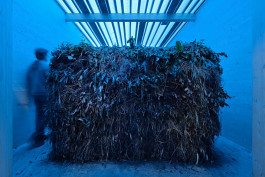
INS 011 Laubreise Lois & Franziska Weinberger 2009
Header image:
53. Biennale di Venezia
Austrian Pavilion
© Herta Hurnaus
Text I: Giulia Guzzini | domus
Text II: Lois Weinberger
"In the plants' state of dissolution (just like insects are ultimately what flowers are about) natural beauty, which can't be grasped anyway, mutates into the reason for diverse events. Decay as an interstice generates time/ arbitrariness/ which is only no longer perceived as such when it repeats itself. The space of art reflects the space of the existential — that of 'Making Good Soil' — (an act of culture). In fact, something of an alchemistic process is happening — leaves travel — in the complexity of the indeterminate (Engagement with nature ends with your own body)."
Lois Weinberger (2008)
A tempietto, sited at an angle of the Austrian pavilion, hewn from coarse timber; a roof of blue plastic tarpaulin, loosely fitted; two steps leading up to an open entranceway; and inside: a huge compost heap, affording little space for visitors, who breathe in the odour of the decomposing plants and have close up view of plants slowly turning back into earth. Creation and decay, nature, culture, art, a multi-sensory preception.
Lois Weinberger worked on a poetic-political network that draws our attention to marginal zones and questions hierarchies of various types. Weinberger, who saw himself as a field worker, embarked in the 1970s on ethno-poetic works that formed the basis for his ongoing artistic investigations of natural and man-made spaces. Ruderal plants — “Weeds” — involved in all areas of life, are initial and orientation point for notes, drawings, photographs, objects, texts, films as well as big projects in public space.
© Herta Hurnaus

© Giulia Guzzini

Related Projects

INS 011 Laubreise Lois & Franziska Weinberger 2009
Header image: 53. Biennale di Venezia, Austrian Pavilion
© Herta Hurnaus
Text I: Giulia Guzzini | domus, Text II: Lois Weinberger
"In the plants' state of dissolution (just like insects are ultimately what flowers are about) natural beauty, which can't be grasped anyway, mutates into the reason for diverse events. Decay as an interstice generates time/ arbitrariness/ which is only no longer perceived as such when it repeats itself. The space of art reflects the space of the existential — that of 'Making Good Soil' — (an act of culture). In fact, something of an alchemistic process is happening — leaves travel — in the complexity of the indeterminate (Engagement with nature ends with your own body)."
Lois Weinberger (2008)
A tempietto, sited at an angle of the Austrian pavilion, hewn from coarse timber; a roof of blue plastic tarpaulin, loosely fitted; two steps leading up to an open entranceway; and inside: a huge compost heap, affording little space for visitors, who breathe in the odour of the decomposing plants and have close up view of plants slowly turning back into earth. Creation and decay, nature, culture, art, a multi-sensory preception.
Lois Weinberger worked on a poetic-political network that draws our attention to marginal zones and questions hierarchies of various types. Weinberger, who saw himself as a field worker, embarked in the 1970s on ethno-poetic works that formed the basis for his ongoing artistic investigations of natural and man-made spaces. Ruderal plants — “Weeds” — involved in all areas of life, are initial and orientation point for notes, drawings, photographs, objects, texts, films as well as big projects in public space.

© Herta Hurnaus

© Giulia Guzzini
Related Projects


